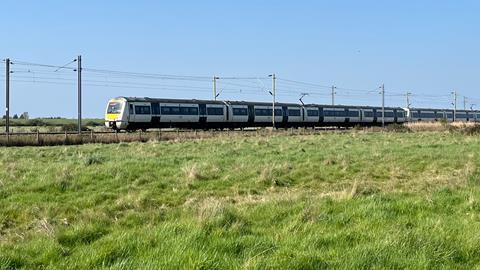Sometimes misrepresented as a recently modernised operation, the c2c suburban business which runs trains between London and Essex is in need of investment. Managing Director Rob Mullen sets out his priorities to Nick Kingsley.
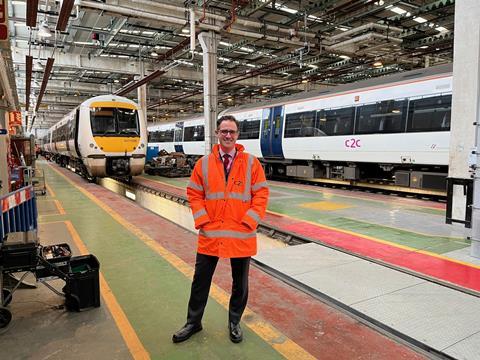
UK: Amid the wider uncertainty facing the structure of Britain’s rail industry, c2c Managing Director Rob Mullen tells Rail Business UK that the Essex and east London operator is doubling down to focus on local issues along its route.
The c2c service between London, Tilbury, Southend and Shoeburyness has been run by the Trenitalia UK subsidiary of Italian state railway FS Group since 2017, when National Express left the UK rail franchise market.
Prior to the pandemic, c2c had been a profitable operator paying a premium to government based on strong commuter patronage in and out of its terminus at London Fenchurch Street in the heart of the City.
At that time, Trenitalia was taking on a franchise running from 2014 to 2029, with the operator expected to pay the Department for Transport premia of around £1·5bn. As the franchising model unravelled during the Covid-19 crisis, c2c was transferred to a National Rail Contract which it signed with the government on July 19 2021. This runs until July 2023.
Mullen acknowledges that the pandemic has radically altered the financial outlook of the operation. ‘The industry as a whole does not want to be a burden on the taxpayer. We need to get back to a position where we are making a net profit, free of subsidy’, he insists. But c2c ridership is running at around 70% of pre-crisis levels, he reports; the missing 30% of passengers represent a significant revenue gap, especially on a network which had traditionally been highly reflective of central London employment patterns. ‘Broadly speaking, weekends are booming and we are very busy on midweek commuter services’, he explains. ‘But midweek off-peak and Monday and Friday travel are just not busy enough.’
Driving revenue
Mullen is blunt in his assessment of immediate growth opportunities. ‘We have to be very aware in the current economic outlook of the cost of adding more trains’, he admits, although some tweaks are being made for the December timetable change to enable some faster rush-hour journeys between Southend and London. More emphasis is being placed on revenue protection, and Mullen suggests that he would like to look at other models of driving customer-friendly investment that do not require funding from DfT or the Treasury.
‘We are lucky in that we are well regarded in our community in Essex — people locally know they can pretty much turn up and get a train which is clean and reliable’, he says. However, he aspires to more. ‘We are already very engaged with organisations like Essex Chamber of Commerce for example — can we use that opportunity to fund station refurbishment from private sources?’ The problem for operators is that with the government’s plans to create Great British Railways seemingly in abeyance for now, ‘we just want to get on and use our private sector understanding to bring growth back. I am certain we can do that.’
Growth over cuts
Mullen is equally adamant the government cannot simply address its concerns about industry costs through cuts to services and passenger amenities. ‘You can’t just drive down costs — you have to grow revenue. I wish this was appreciated more widely. Cuts to services deter passengers, and that then harms the local economy. Think of how many small businesses cluster around stations. You risk causing damage outside the rail sector’, he argues.
‘If we want to build a profitable, good service for customers, we cannot cut our customer proposition any further — people use us as a turn up and go service so we have to provide that.’

Reflecting on his discussions with the government about the challenges facing the railway, Mullen suggests that operators and DfT do share a common desire to see ridership return. ‘I believe that they want the industry to grow too.’
Initial thinking around the future structure of the industry under GBR had suggested that suburban operators like c2c were likely to be locked into highly prescriptive contracts focused mainly on operational delivery, while inter-city and medium-distance operators could be given more commercial freedom. Mullen is wary.
‘Post-pandemic, c2c is not just a commuter railway. Nor are we a metro. There is tourism in Essex; Southend has just been granted city status, and we have growing traffic away from London in the peaks. We can target these trends and grow the business.’
Climate resilience
One emerging risk to growing traffic on the Essex Thameside network is its resilience to changing weather patterns. Mullen says he has ‘an excellent relationship’ with Network Rail’s Anglia Route, led by Ellie Burrows, but the heatwave seen earlier this year has posed major problems which could become endemic.
A particular challenge is the clay-heavy soil underpinning much of the formation. Mullen explains that in hot weather the clay dries rapidly, but it quickly decays when any rain falls, potentially affecting the stability of the alignment. This leads to widespread imposition of speed restrictions and also affects the ability of NR and its contractors to tamp the track. Mullen says that the situation is sufficiently serious that it may seek to apply a temporary summer timetable for 2023.
A further problem is subsidence, reflected in particular by problems at Basildon station. The end of the down Southend-bound platform has started to subside, leading c2c to reduce the length that can be used by the public. This in turn has led to a restriction on train lengths from the previous 12 to eight cars, creating a significant constraint at one of the routes major stations. ‘NR Anglia are doing a fantastic job but in the current context, their resources are stretched too.’
Rolling stock and infrastructure
Climate resilience is just one factor in a complex outlook for the railway. Investment is urgently required in Control Period 7, Mullen believes. ‘My view is that we need attention to the lineside assets, especially the ageing electrification equipment and some of our bridges, embankments and viaducts.’ He cites a 30 km/h speed restriction applied on the approaches to Fenchurch Street earlier in the year.
Although both the route and the rolling stock was modernised in the mid-1990s and was at the time held up as an early success of privatisation, Mullen believes there is a misplaced belief about c2c being a ‘new’ operation. The Class 357s EMUs ‘were the the first Electrostars’ and are now more than 20 years old, he says. Their wi-fi needs upgrading and they are not fitted with power sockets and USB ports which is ‘a major issue when we need to attract customers back. Simply saying the train will be very clean doesn’t cut it.’
Like the infrastructure, the trains are also struggling with the changing climate. Mullen admits that the HVAC on the Class 357 fleet is ‘not hugely effective’ amid the consistently rising summer temperatures seen in recent years.
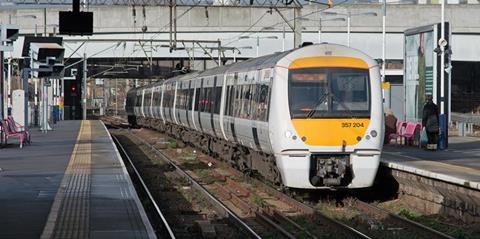
The operator is currently in the process of accepting 12 Class 720 Aventra EMUs from Alstom’s Derby plant. But Mullen is keen for the industry and government to think more strategically about rolling stock. ‘We must co-ordinate fleets better, and if there were to be some kind of rolling stock cascade, we would be very interested. Ourselves, Greater Anglia and Arriva Rail London all run Aventras for example.’
He says he has made clear to DfT that c2c is ‘very keen to be involved in digitalisation’ of its operations. Initially this would focus on deploying established technologies such as Selective Door Operation, but he acknowledges that the route could be well suited in the longer term for deployment of ETCS and ATO. While c2c’s parent Trenitalia has the engineering skills to fit its domestic fleets with ETCS onboard equipment in-house, he doubts such an approach would currently be fundable in the UK market.
Trenitalia committed
Mullen is quick to praise c2c’s parent as ‘a really forward-looking group with a wide range of international experience we can tap into’. He dismisses suggestions that the current uncertain industry outlook could see FS Group quit the British market — its other main involvement is through a minority shareholding in the FirstGroup-led Avanti West Coast.
‘There is no desire to hand the keys back from what I can tell’, Mullen says. ‘Trenitalia has been nothing but supportive throughout my time with the business.’
A further incentive for the Italian national railway to stay the course through the reform programme is likely to be its desire to further deploy the PICO4UK ticket issuing system, which has replaced seven separate legacy retailing systems to integrate c2c’s ticket machines, ticket offices, website and app. Trenitalia developed PICO4UK to replicate a system which it has used in Italy for the past decade.
Busy bees in the community
Meanwhile, c2c is redoubling its efforts to deliver small, immediate improvements to communities along its route. ‘We want to show as a management team that we can deliver tangible benefits. I firmly believe small improvements can really make people feel better — this isn’t about what things cost’, Mullen insists.
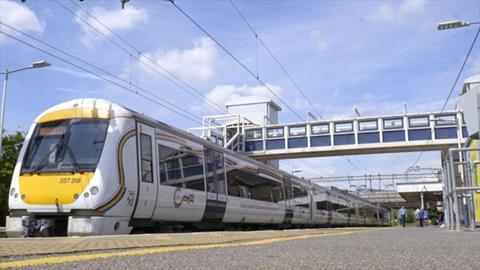
Under a programme known as Operation Bumblebee, directors and managers from the operator are undertaking work at 31 sites to ‘make a difference for customers, colleagues or the environment’. Recent projects include the planting of flowers around the entrance to Pitsea station.
Another high-profile example of community work are the train wraps c2c has introduced this year, including a ‘Trainbow’ for Southend Pride in July, and a charity partnership and train wrap for charity Gold Geese to mark childhood cancer awareness month in September.
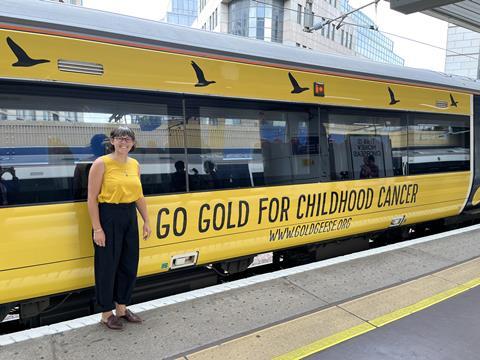
‘We are putting a lot of effort into ensuring that we give our staff time to volunteer and help their communities. We also want to make sure that everyone feels comfortable and welcomed at work — if the Trainbow initiative helps even one person feel that way as a result, I am happy’, Mullen explains.
Looking at the broader picture, Mullen notes that the c2c network passes through areas facing significant economic and social challenges. ‘We definitely see investment in our railway as a form of “levelling up”, even though we are in the southeast of England.’

